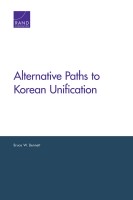| 来源类型 | Research Reports
|
| 规范类型 | 报告
|
| DOI | https://doi.org/10.7249/RR2808
|
| ISBN | 9781977401830
|
| 来源ID | RR-2808-KOF
|
| Alternative Paths to Korean Unification |
| Bruce W. Bennett
|
| 发表日期 | 2018
|
| 出版年 | 2018
|
| 页码 | 118
|
| 语种 | 英语
|
| 结论 |
The analysis of nine alternative paths to Korean unification suggests that neither South Korea nor North Korea is ready for a successful unification- North Korean leader Kim Jong-un appears to be unwilling to consider a path in which he does not have a clear win in the unification process. South Korean President Moon Jae-in appears to be more prepared for some form of unification compromise, but he has yet to take the actions needed to make a unification that benefits both South and North Koreans.
- The peaceful unification paths appear to be (1) infeasible to achieve or (2) unstable or likely failures because of the isolation from outside information and influence that the North Korean regime requires to maintain its position of power.
- The difficulties associated with the peaceful unification paths make it clear that the Kim family regime is the ultimate impediment to full Korean unification.
- A negotiated unification after North Korea's regime collapses is likely the best path for unification. To facilitate this or any other unification path, South Korea needs to develop policies now that would provide most North Korean elites with a friendly outcome from unification.
- Several experts on Korea believe that the only path to a stable unification involves regime change in the North followed by a gradual, cooperative, peaceful advance toward unification working with the new North Korean government, likely lasting for many years.
- North Korean weapons of mass destruction and Chinese intervention would be the most serious challenges to Korean unification.
|
| 摘要 |
- South Korea must avoid using a major war to obtain unification, even in the case of a collapse of the North Korean regime; the cost would simply be too high.
- South Korea needs to develop policies now that would provide most North Korean elites with a friendly outcome from unification. Doing so is essential to achieving a solid initial unification and to making unification sustainable.
- South Korea and the United States should counter North Korean efforts to create conditions that would allow North Korea to lead unification. In particular, South Korea and the United States should refute Kim Jong-un's image in North Korea as a god-like leader and his image in South Korea as a benevolent peacemaker. He is neither.
|
| 主题 | China
; International Diplomacy
; North Korea
; Politics and Government
; South Korea
; United States
; Weapons of Mass Destruction
|
| URL | https://www.rand.org/pubs/research_reports/RR2808.html
|
| 来源智库 | RAND Corporation (United States)
|
| 引用统计 |
|
| 资源类型 | 智库出版物
|
| 条目标识符 | http://119.78.100.153/handle/2XGU8XDN/108898
|
推荐引用方式
GB/T 7714 |
Bruce W. Bennett. Alternative Paths to Korean Unification. 2018.
|
|
文件名:
|
x1541707891012.jpg
|
|
格式:
|
JPEG
|

|
文件名:
|
RAND_RR2808.pdf
|
|
格式:
|
Adobe PDF
|
除非特别说明,本系统中所有内容都受版权保护,并保留所有权利。